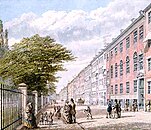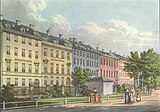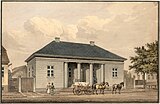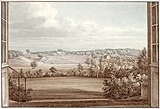Heinrich Gustav Ferdinand Holm
Heinrich Gustav Ferdinand Holm | |
|---|---|
 Self-portrait | |
| Born | 23 April 1803 Berlin, Germany |
| Died | 1 May 1861 (aged 58) Copenhagen, Denmark |
| Nationality | Danish |
| Known for | Painting |
Heinrich Gustav Ferdinand Holm, often referred to as H.G.F. Holm, (23 April 1803, Berlin – 1 May 1861, Copenhagen) was a Danish artist and engraver who is remembered for his finely detailed topographical paintings and drawings of Copenhagen and surroundings.[1]
Biography
Holm was born on 23 April 1803 in
On 23 July 1828 in Gentofte, he married to Karen Marie Nielsen (c. 1801 - 1853). They had four children. Despite Holm's high rate of productivity, he constantly suffered from lack of money, which frequently drove him to drink. The resulting vicious cycle encouraged him to sell his works at low prices which explains how he was given the nickname: Fattigholm or "Poor Holm".[2] More recent research indicate that he suffered from mental illness. He died at Almindeligt Hospital in Copenhagen.
Works

Holm's many small works continue to be of considerable value. They are of great topographical and cultural interest as they provide one of the best representations of Golden Age Copenhagen, both in terms of the city as a whole and its individual buildings, including life in the streets. In addition, thanks to their high technical quality and his sense of colour, his watercolours are of high artistic quality.[2]
Gallery
-
Trinitatis Church and Rundetårn: watercolour
-
Christiansborg Palace
-
Charlottenlund
-
Sankt Annæ Plads, watercolour
-
Dronninggård (1826)
-
(1804-1861) Udsigt fra Rundetårn
-
Kgs. Nytorv, (1830)
-
Peschiers Gård (1803)
-
Kronprinsessegade (1845)
-
Kronprinsessegade (1830)
-
View of an Interior (1826)
-
(1829)
-
(1829)
-
View from backyard towards Rundetårn
-
(1851)
-
(1852)
-
Løngangsstræde
-
(1830)
-
View Outside from the Garden Hall at Frederiksdal Manor House
-
Bakkehuset i Vedbæk (1858)
-
Botanist and zoologist Martin Vahl Henrichsen's tombstone at Assistens Kirkegård
-
Self Portrait
-
Garden interior with pavilion from old Frederiksberg property
-
(1853)
-
(1835)
-
(1838)
References
- ^ "H.G.F. Holm", Den Store Danske. (in Danish) Retrieved 16 June 2011.
- ^ a b John Erichsen, "H.G.F. Holm", Kunstindeks Danmark & Weilbachs Kunstleksikon. (in Danish) Retrieved 16 June 2011.



































